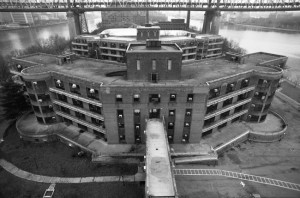A recent article on the impending demolition of the Coler-Goldwater Hospital on Roosevelt Island by the architect and photographer Charles Giraudet raises an important question. The Goldwater portion of the hospital (originally called Welfare Hospital) opened in 1939. It was designed by Isadore Rosenfield, a Harvard educated Russian immigrant who was the Chief Architect of the Department of Public Works and in charge of New York City’s $100 million hospital building program. The architecture is modernist, with Art Deco motifs, and a chevron plan that presages Louis Kahn. As Giraudet, who has been documenting the empty buildings prior to their demolition, writes: “All major programming decisions — from the number of beds to the general layout of the buildings, the angled wings of the wards and the relative heights — were related to an unwavering patient-centric design approach.”
Rosenfield’s design bears comparison with Aalto’s Paimio Sanatorium (1933) and Le Corbusier’s unbuilt proposal for Venice (1966). The question raised by Giraudet’s article and the evocative accompanying photographs, is why healthcare facilities are no longer built with any significant degree of architectural ambition. Most are generic environments, at best. Is it because machinery, rather than sunlight and fresh air, dominates healthcare today? Or do hospitals no longer turn to “design architects” because the latter have nothing to offer except a concern with fashion, which is of little import in a healing facility? I would like to see a hospital designed by an imaginative and thoughtful architect such as Bill Rawn or Peter Bohlin. Research into evidence-based design has shown the importance of environmental factors in health outcomes: views of nature lower stress, for example, so do natural materials. Architecture may yet re-enter the equation. Of course, a lot will depend on exactly how architects respond. Form alone won’t cut it.



Herzog and de Meuron are supposed to design <a href="http://www.archdaily.com/495113/herzog-and-de-meuron-to-design-one-of-denmark-s-largest-hospitals/"this hospital in Denmark. However patient-centric, most high-budget hospitals are designed for population centers and constrained footprints. Building <a href="http://hga.com/work/east-texas-medical-center#/east-texas-medical-center-pittsburg-healthcare-campus-interior-2"smaller clinics in smaller towns where there is room for experimentation has not attracted many careerists, but there is good work being done.